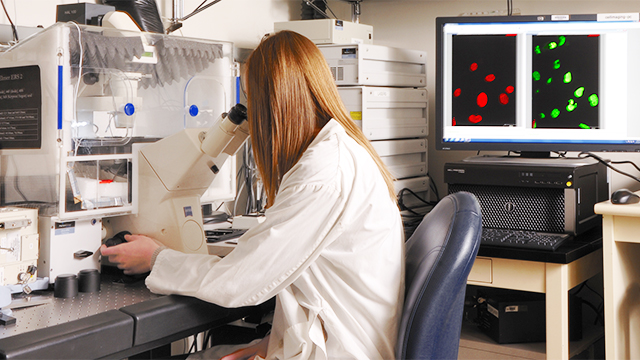
(Photo courtesy of the Cross Cancer Institute)
On May 25, the University of Alberta's Department of Oncology at the Faculty of Medicine & Dentistry celebrates its 25th anniversary.
Housed within the Cross Cancer Institute in Edmonton, the department is encompassed by seven divisions and more than 150 faculty members, with growing numbers of undergraduate and graduate students every year.
"Canada has 17 schools of medicine and only seven of them have a freestanding department of oncology, so we are somewhat unique," explained David Eisenstat, current department chair of oncology.
The celebration sheds light on a long journey to solidify the specialty of oncology in Alberta for the improvement of cancer detection and treatments.
Building milestones and 'firsts'
The Division of Oncology became a department in 1993 under the leadership of professor emeritus Tony Fields, who acted then as interim chair. Later on, Carol Cass would be appointed the first official chair of the Department of Oncology, setting a precedent for a team of trailblazers and pioneers.
Initially, there were undergraduate oncology courses for the MD program; graduate programs were developed at the graduate and PhD levels in medical sciences (oncology), as well as postdoctoral training.
"This evolution was really a boom," said Fields. "Where there were few master and PhD candidates at the Cross Cancer Institute before, come the Department of Oncology, those networks grew and grew. This is a thriving hub of training activity."
Today, there are accredited clinical residency programs in medical oncology, radiation oncology, palliative care and medical physics.
The latest addition in education was the Bachelor of Science in Radiation Therapy undergraduate program, an initiative conceptualized and led by professor and former department chair Sandy McEwan.
The department has achieved numerous accomplishments through the years. The radiobiology research group that stemmed from the department was the first in the world to bring radiation sensitizers into clinical trials to improve the response of tumours to radiation.
In 2008, medical physicists led by professor and researcher Gino Fallone produced the first image from a linear accelerator (LINAC-MR) hybrid system in the world.
The advances in fundamental and translational research have allowed the department to consistently apply new approaches to cancer treatment through clinical trials, keeping high rates of patient enrolment in trials with increasingly positive outcomes.
"I've been amazed over the years when people that I know from outside of Alberta say, 'Wouldn't you want to go someplace else for cancer care?' And I have always felt that we actually do have access to the highest quality of care right here," said Cass.
Allies against cancer
The Department of Oncology was initially created with the extensive support of the Alberta Cancer Board (now Cancer Control Alberta, Alberta Health Services) and the generous philanthropic support of donors and organizations.
Today, Alberta Health Services through Cancer Control and the Cross Cancer Institute, the Alberta Cancer Foundation and the Cancer Research Institute of Northern Alberta (CRINA) are the department's key partners, providing support in infrastructure and funding for its education programs, research and clinical care, as well as interdisciplinary work environments. All past and present leaders of the department recognize with gratitude the critical role played by these entities in the growth of oncology at the University and at a provincial level.
"Partnerships in cancer are essential," said Eisenstat. "Cancer research can't just be done by individuals or even individual centres anymore. We have to be part of a larger group and be fully integrated to these networks."
Eisenstat attributes part of the success of the department to its collaborative approach to research.
Looking to a bright future of oncology in Alberta
The U of A's Department of Oncology is celebrating its anniversary with the inauguration of an innovative hybrid imaging scanner (PET-MR), which combines magnetic resonance imaging (MRI) and positron emission tomography (PET). This acquisition will take the department further in the development of precision health initiatives.
"It takes an image from being a picture to being a biomarker and will start to give clinicians the information they need to provide personalized treatment," explained McEwan. "That is huge."
"There are so many milestones in the Department of Oncology. This is just a crowning glory."
Other future plans for the department include the development of graduate programs in radiation therapy and novel options of treatment with radiotracers for early cancer detection, and immunotherapy.
Fields looks back to this journey of 25 years with satisfaction.
"What I'm most proud about the Department of Oncology was being there from when it was first conceived-and I could talk for hours about all that it took to establish it-and then to see this department grow to what it is today-a powerhouse within the U of A's Faculty of Medicine & Dentistry and among departments of oncology across the country."
"I look at the future with a lot of recognition to the past," added Cass. "We are a group of maturing Alberta-based scientists and clinicians who are committed to the improvement and understanding of cancer."
"I see amazing opportunities for cancer research in Alberta."
"We've done a lot. We hide our light under a bushel, we need to be more aggressive," said McEwan. "(Other centres) are supreme marketers; we just get on and do the work."
Learn more about the Faculty of Medicine & Dentistry's Department of Oncology in this video: